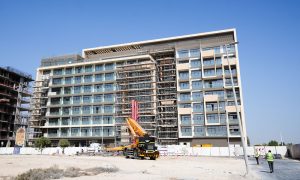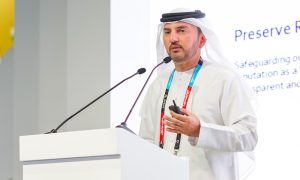Tall storeys at first CTBUH event in Dubai
The Dubai chapter of the Council on Tall Buildings and Urban Habitat held its long-awaited inaugural event in December

Dubai may be home to 8% of the world’s skyscrapers, as well as the tallest structure on the planet, yet it took until last month for the Council on Tall Buildings and Urban Habitat (CTBUH) to hold its inaugural session for its chapter in the emirate.
The event, held on 10 December at Vida Hotel and Resorts, was a “long time coming” according to Dean McGrail, one of CTBUH’s two Dubai representatives and director of specialist services at WSP, who remarked that the inaugural session had been on the cards since 2012.
With three offices around the world – a headquarters in Chicago, a new office in Shanghai and a research hub in Venice – CTBUH is best known as the global authority on building heights. Yet the council offers far more than just statistics to its impressive 1.3 million members worldwide. The not-for-profit organisation holds worldwide seminars, networking events, building tours and tall buildings awards, as well as an annual international conference, next in New York City on October 26-30, 2015.
CTBUH also draws on its members’ expertise to produce documents on specific areas of tall buildings, with 12 working groups covering the latest developments in subjects such as BIM, facades, security and fire & life safety.
McGrail drew attention to a project called the Research Roadmap, set up by CTBUH, UNESCO and the International Council for Research and Innovation in Building and Construction (CIB). “It has three primary objectives – to look at the important research that we need for tall buildings, any gaps in current tall building research, and any programmes for research moving forwards.”
One of the current CTBUH research projects is a study on dealing with high-rises that have become obsolete. “There is a huge task ahead of us in very dense high-rise cities, like New York and Hong Kong, when the building stock becomes outdated and needs to be dismantled. How do you go about demolishing something like JBR, for example?”
When it comes to measuring tall buildings, CTBUH’s method is floor to architectural top. Cohost Mark Lavery, CTBUH Dubai representative and associate director – Tall Buildings at Buro Happold, explains: “Architectural top can be towers, spires – anything that doesn’t have a function. That was one of the key things that put One World Trade Center in third place in the overall list. It was quite contentious at the time. The Willis Tower [in Chicago, formerly the Sears Tower] has antennae which put them at a great height but don’t count because they have communication purposes.”
He also notes that ‘highest occupied floor’ is another, unofficial, method of measuring buildings. “That can be widely different from the architectural tip. With Burj Khalifa, the last usable floor is about 70% of its height, as is [the case in] One World Trade Center.”
Around 11% of the council’s members are from the Middle East, with existing chapters in Abu Dhabi and Qatar. “That is something that we are looking to increase,” says McGrail.
Referring to data compiled by CTBUH on its extensive website, Skyscraper Center, Lavery comments: “Since 2000 [the Middle East] has been at the centre of tall building development throughout the world. Up until the 1990s, it was completely dominated by the United States. Now we have a large percentage in Asia and the Middle East.”
Lavery also highlights the evolving function of high-rise buildings. “The buildings of North America were all primarily office-based. Now we’re seeing that residential and mixed use are starting to really dominate. Less than half of the hundred tallest are actually office.”
CTBUH statistics reveal that Dubai has 168 buildings over 150m in height. Of those, 51% are residential, 21% are mixed use, 18% are office, 8% are hotels and 2% are serviced apartments. The functional split is very different from New York City, which features 58% office, 24% residential and 11% mixed use towers.
The predominant structural material has also changed, with steel now less prevalent. Lavery explains: “[Skyscraper builders] in the Middle East and Asia are more comfortable with concrete in general. Steel has typically been taken as more expensive, so we are starting to see concrete and composite buildings really dominate tall buildings.”
According to the website, 94% of Dubai’s skyscrapers are built with concrete, while only 3% are steel/concrete and 3% are composite. In the case of New York City, 62% are built with steel while 31% used concrete. Reflecting the rapid recent expansion of the emirate, the average age for a tall building is a mere six years, compared to 38 in New York City. Elsewhere, the average age for a skyscraper is 11 in Shanghai, 13 in Hong Kong and 15 in Singapore. However, Dubai’s skyline is relatively mature compared to Abu Dhabi and Doha, where the average age for a tall building is four and three years respectively.
Lavery reiterates the staggering level of tall building construction in the UAE. “It has 8.4% of the world’s tallest buildings yet only 0.1% of the world’s population – that’s a completely disproportionate amount. It becomes even more unbalanced when you look from [a regional] perspective. The UAE has 66% of the Middle East’s tall buildings and only 1.4% of the population.”
As for the world’s tallest structures, six of the top 20 are in the Middle East, with three in Dubai (Burj Khalifa, Marina 101 and Princess Tower). Yet by 2020, CTBUH predicts that the Middle East will only have three of the world’s tallest. “China will rise up the chart with more tall buildings. By 2020, Kingdom Tower [in Jeddah] and the Pentominium [in Dubai] will have crept in, but at this stage we are completely overtaken by Asia – there are only three in the Middle East. The rest [apart from Burj Khalifa] slide off the list,” comments Lavery.
He also draws attention to the number of unfinished structures in the region. A recent CTBUH study plotted the tallest uncompleted buildings, with site works begun but halted and no indication that construction will continue. The study found that four of the ten tallest are in Dubai, including the 1,000m Nakheel Tower.
In terms of the activities of CTBUH in Dubai, both of the city representatives underline a desire to connect with the local industry by hosting lectures. “We really want to get active. We are thinking of lectures with real subjects that have a use to [people in the industry],” states McGrail.
Globally, the council is aiming to attract more memberships from developers, ultimately the key decision-makers in high-rise projects. “There are a lot of developers listed, but many of them are single person memberships – [CTBUH] are trying to push the organisational membership of developers.”
In addition, the organisation is looking for contributors and experts to share their knowledge by writing papers and journal articles. McGrail adds: “We want to bring in a lot more education for everyone to learn from, and we want to encourage people to start to take part in a meaningful way.”
























